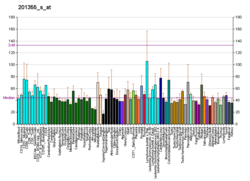| BAZ2A |
|---|
|
| Available structures |
|---|
| PDB | Ortholog search: PDBe RCSB |
|---|
| List of PDB id codes |
|---|
4LZ2, 4Q6F, 4QBM, 4QF2, 5AGQ |
|
|
| Identifiers |
|---|
| Aliases | BAZ2A, TIP5, WALp3, bromodomain adjacent to zinc finger domain 2A |
|---|
| External IDs | OMIM: 605682; MGI: 2151152; HomoloGene: 8393; GeneCards: BAZ2A; OMA:BAZ2A - orthologs |
|---|
| Gene location (Human) |
|---|
 | | Chr. | Chromosome 12 (human)[1] |
|---|
| | Band | 12q13.3 | Start | 56,595,596 bp[1] |
|---|
| End | 56,636,816 bp[1] |
|---|
|
| Gene location (Mouse) |
|---|
 | | Chr. | Chromosome 10 (mouse)[2] |
|---|
| | Band | 10|10 D3 | Start | 127,927,446 bp[2] |
|---|
| End | 127,965,172 bp[2] |
|---|
|
| RNA expression pattern |
|---|
| Bgee | | Human | Mouse (ortholog) |
|---|
| Top expressed in | - sural nerve
- epithelium of colon
- beta cell
- gastric mucosa
- bone marrow cells
- right uterine tube
- left ovary
- body of uterus
- right ovary
- tendon of biceps brachii
|
| | Top expressed in | - zygote
- female urethra
- blood
- hair follicle
- tibiofemoral joint
- lymph node
- mesenteric lymph nodes
- Gonadal ridge
- secondary oocyte
- granulocyte
|
| | More reference expression data |
|
|---|
| BioGPS | 

 | | More reference expression data |
|
|---|
|
| Gene ontology |
|---|
| Molecular function | - DNA binding
- RNA polymerase I core promoter sequence-specific DNA binding
- histone binding
- metal ion binding
- protein binding
- nuclear receptor binding
- lysine-acetylated histone binding
- RNA binding
| | Cellular component | - rDNA heterochromatin
- chromatin silencing complex
- nucleolus
- nucleus
- cytosol
- nuclear speck
| | Biological process | - chromatin remodeling
- regulation of transcription, DNA-templated
- transcription, DNA-templated
- DNA methylation
- rDNA heterochromatin assembly
- histone deacetylation
- RNA polymerase I preinitiation complex assembly
- chromatin organization
| | Sources:Amigo / QuickGO |
|
| Orthologs |
|---|
| Species | Human | Mouse |
|---|
| Entrez | | |
|---|
| Ensembl | | |
|---|
| UniProt | | |
|---|
| RefSeq (mRNA) | |
|---|
NM_001300905
NM_013449
NM_001351156 |
| |
|---|
| RefSeq (protein) | |
|---|
NP_001287834
NP_038477
NP_001338085 |
| |
|---|
| Location (UCSC) | Chr 12: 56.6 – 56.64 Mb | Chr 10: 127.93 – 127.97 Mb |
|---|
| PubMed search | [3] | [4] |
|---|
|
| Wikidata |
| View/Edit Human | View/Edit Mouse |
|





















